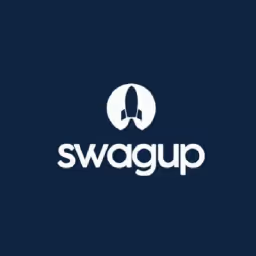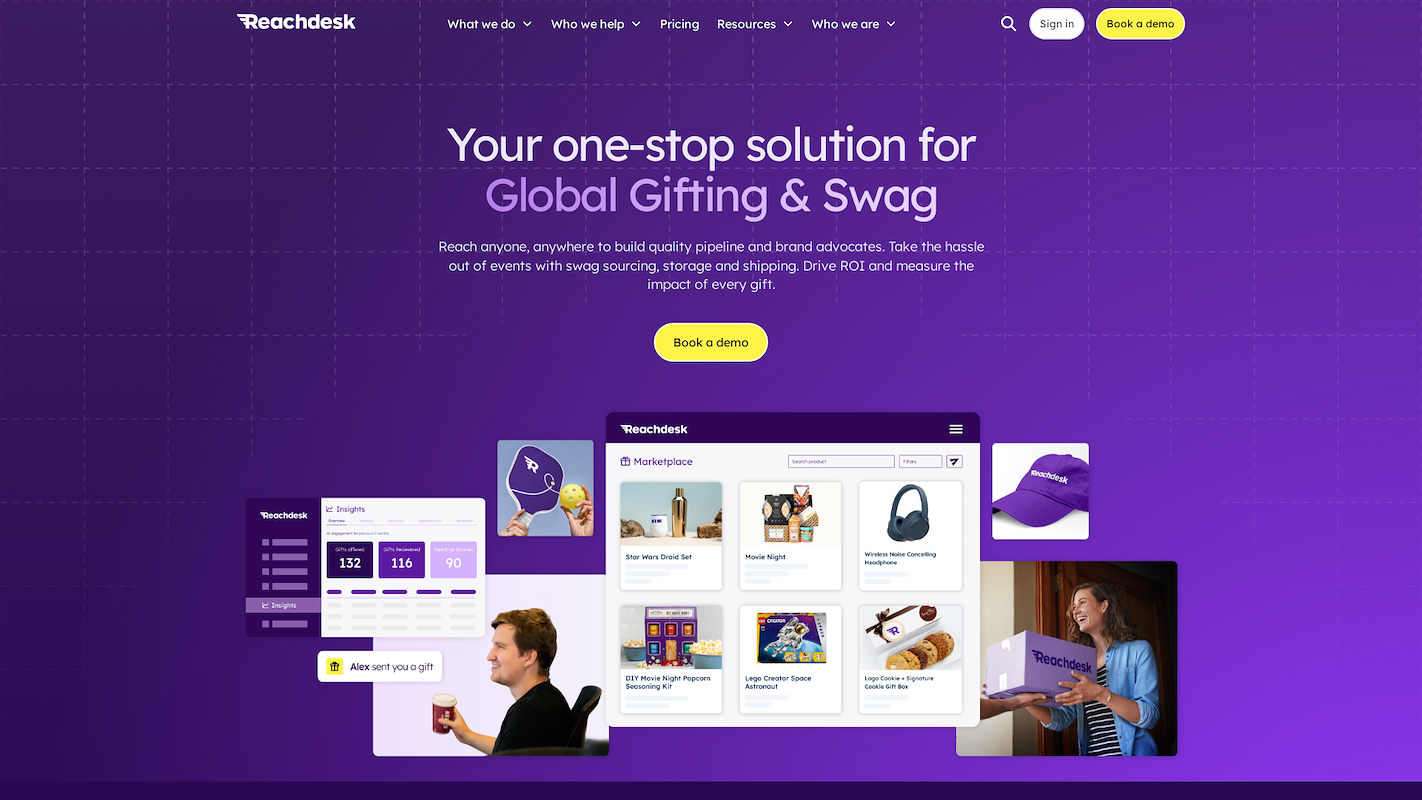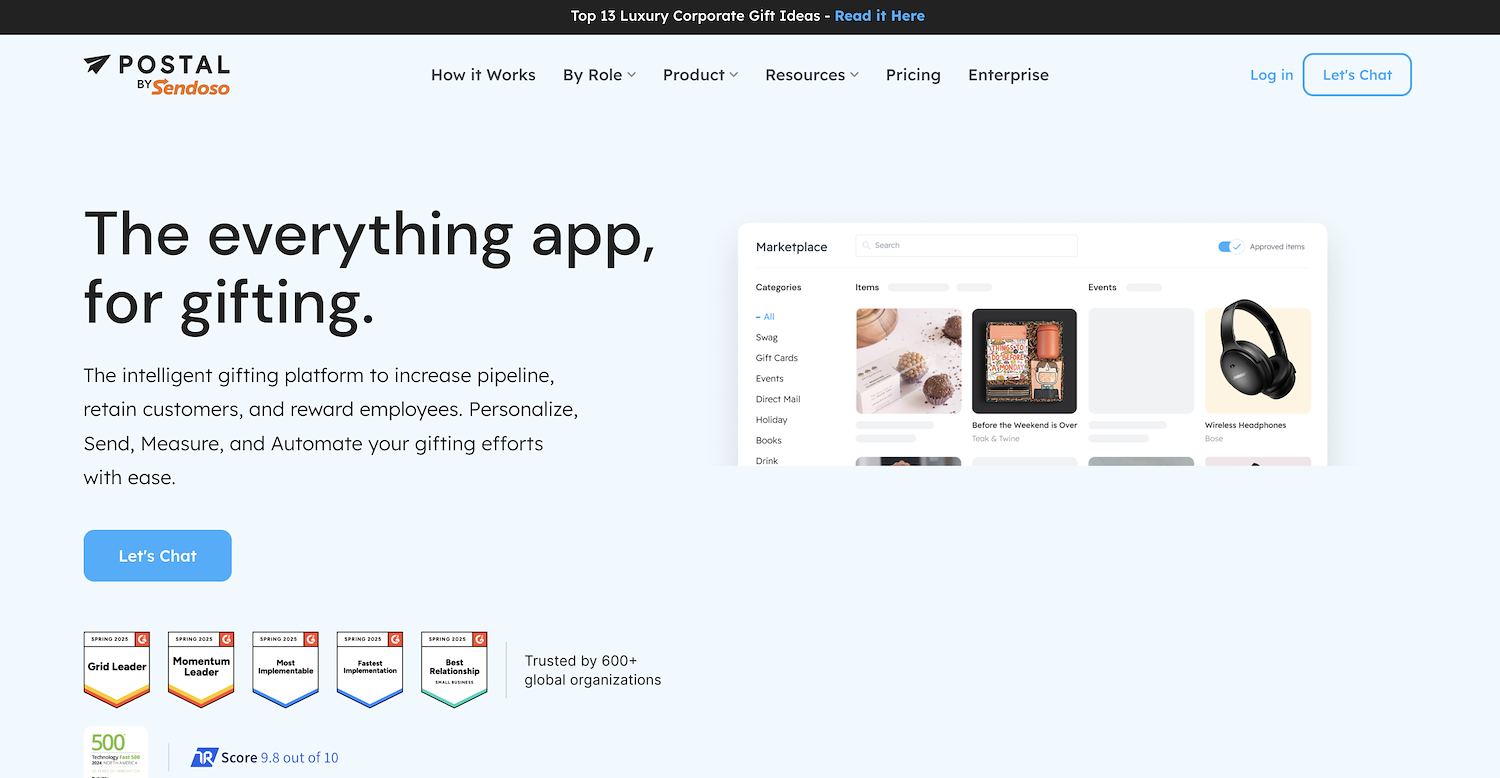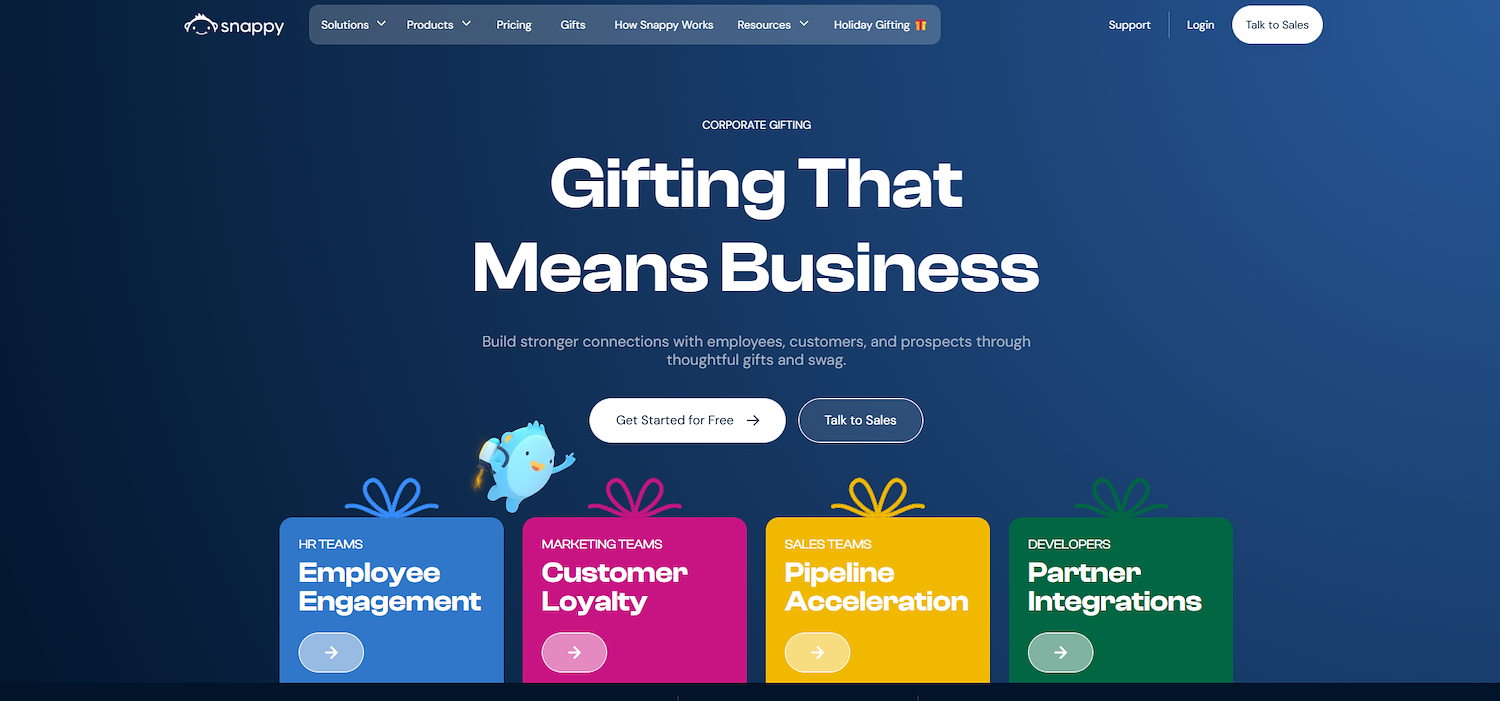SwagUp Alternatives
Compare 10 SwagUp alternatives. This guide reviews each platform's features, pricing, and capabilities to help you find your next swag partner.

You might be using SwagUp for good reasons. Its platform makes managing company swag and gifting straightforward. For many teams, it’s a solid choice for designing, buying, and shipping branded items without much hassle.
However, some users report occasional issues like delivery delays, limited product options, or slow support. We've analyzed top alternatives based on G2 reviews, comparing their pros and cons to help you find a better fit for your needs. Let's get started.
A Quick Look at 11x
If your team also wants to automate sales tasks, look into 11x. Their digital workers handle prospect research and outreach, which can complement your gift strategy.
Now, let's dive into the SwagUp alternatives.
11x is an all-in-one GTM platform where AI agents manage your sales operations. Alice finds prospects, conducts outreach via email and LinkedIn, and updates your CRM. Julian qualifies incoming leads and books meetings directly on your calendar.
This approach replaces the need for separate tools for data enrichment, sales outreach, or email warmup. 11x combines these functions into a single platform, which can simplify your GTM stack.
SwagUp Alternatives
The following sections provide a detailed breakdown of each SwagUp alternative. We analyze pricing, features, and the specific pros and cons of each platform relative to SwagUp.
1) Sendoso

Sendoso is a platform for direct mail and gifts. It helps sales, marketing, and HR teams create personalized outreach. The system supports account-based marketing campaigns, sales development, and customer loyalty programs.
It aims to open doors and accelerate sales pipelines through tangible sends. The company also handles global storage and fulfillment, with a focus on data-driven campaigns to connect with prospects and customers.
Sendoso's Main Features
- Integrates with over 90 native platforms to automate gifting within existing GTM tech stacks.
- Provides AI-powered “SmartSend” recommendations for personalized and timely gifts.
- Includes full-stack reporting and real-time dashboards for campaign attribution.
- Offers a 5x ROI guarantee and a marketplace price-match guarantee.
How Sendoso Compares to SwagUp
Average Review score: 4.5/5 stars based on 1,176 G2 reviews.
- Sendoso connects with over 90 platforms, including Salesforce and HubSpot. This allows for automated gifting within existing sales workflows, a more extensive integration than SwagUp offers.
- The platform provides a wider variety of options, including eGifts, direct mail, and an Amazon integration. This gives more flexibility compared to SwagUp's primary focus on branded company merchandise.
- It offers advanced analytics with real-time dashboards to track campaign attribution and ROI. While SwagUp provides tracking, Sendoso's reporting is more detailed for data-driven teams.
- The tool uses AI to suggest personalized gifts at the right time. This feature helps automate outreach decisions, a function not available in SwagUp.
Potential Drawbacks Compared to SwagUp
- Sendoso's platform can be more expensive. Some users note high costs for shipping and certain items, which might make SwagUp a more budget-friendly choice for straightforward swag management.
- Its user interface can feel complex for new teams. Compared to SwagUp's more direct platform, Sendoso may require a longer onboarding period to learn all its features.
- Some users report occasional delivery delays or inconsistent shipping times. This can be a factor for time-sensitive campaigns, where SwagUp's focus on branded merchandise might offer more predictable logistics.
Cost and Budget Considerations
While both platforms are perceived as premium-priced, G2 user data suggests Sendoso may offer a faster return on investment. On average, users report a 14-month ROI for Sendoso versus 27 months for SwagUp, with a shorter implementation time.
2) Printfection

Printfection, now part of Custom Ink, is a swag management platform. It lets teams create, store, and ship branded merchandise anywhere. The system manages logistics from product source to inventory for marketing, sales, and HR departments. It supports direct mail for lead generation, account-based marketing campaigns, and customer rewards.
Printfection's Main Features
- Offers swag giveaways through unique redemption links and landing pages.
- Provides self-serve company swag stores for employees or customers.
- Includes eGift cards from more than 200 international retailers as a digital option.
- Creates customized swag boxes for curated unboxing experiences.
How Printfection Compares To SwagUp
Average Review score: 4.4/5 stars based on 357 G2 reviews.
- Printfection integrates with marketing automation platforms like Marketo and HubSpot. This allows for automated swag sends from within those systems, a different approach to integration compared to SwagUp.
- It offers event-specific services, such as pre-sorting apparel by size and accepting returns of unused items. This provides logistical support for events that may not be standard with other swag platforms.
- The platform shows a shorter time to return on investment in G2 user data. Users report an average ROI of 19 months, compared to the 27 months reported for SwagUp.
- Each customer receives a dedicated account manager. This creates a personalized support structure, which is different from SwagUp's standard support model.
Potential Drawbacks Compared To SwagUp
- Some users report a learning curve with Printfection's platform due to its many features. In comparison, SwagUp is often described as more straightforward for basic swag management.
- The platform is sometimes considered a premium-priced option. For teams with tight budgets, SwagUp might present a more cost-effective solution, as some users note Printfection's higher costs.
- Printfection's wide range of services, like event support, may add complexity for teams that need only simple swag fulfillment. SwagUp’s more focused approach can be a better fit for those specific use cases.
Cost and Budget Considerations
Both platforms are perceived as premium-priced, but G2 user data suggests Printfection may provide a faster return on investment at 19 months versus 27 for SwagUp. Since specific pricing models can vary, we recommend visiting Printfection's official website for the most current information.
3) Alyce

Alyce is a B2B platform for corporate gifts and direct mail. It helps revenue teams win and retain customers through personalized outreach. The software supports outbound sales sequences and ABM programs. Data shows it can double win rates, increase second-call rates sixfold, and shorten deal cycles by 29%.
Alyce's Main Features
- It uses AI to generate gift recommendations for one-to-one outreach.
- Recipients can exchange gifts through a "Power-of-Choice" marketplace with thousands of options.
- Senders can require recipients to complete an action, such as booking a meeting, to claim a gift.
How Alyce Compares To SwagUp
Average Review score: 4.7/5 stars based on 548 G2 reviews.
- Alyce uses AI to recommend personal gifts for each recipient. This is different from SwagUp, which focuses on distributing pre-selected company swag.
- The platform gives recipients the choice to exchange a gift for another item or donate its value. SwagUp sends a specific item without this option.
- It allows you to require an action, such as booking a meeting, before a person can claim a gift. This feature is not part of SwagUp's standard process.
- G2 user data shows a faster return on investment for Alyce at 11 months, compared to 27 months for SwagUp.
Potential Drawbacks Compared To SwagUp
- Alyce's platform centers on a marketplace of curated gifts. This provides less direct control over the design and production of custom-branded merchandise compared to SwagUp's model.
- The tool's "Power-of-Choice" feature means it does not focus on warehousing a company's specific inventory of branded items, which is a main service SwagUp provides.
- Some users report that the selection of physical gifts can be limited, especially for lower-cost items or in certain countries, which is different from SwagUp's approach of creating a specific swag catalog.
Cost and Budget Considerations
While we've covered key features and use cases in this comparison, pricing models can vary significantly between tools. For the most accurate and up-to-date pricing information, we recommend visiting Alyce's official website.
4) Reachdesk

Reachdesk is a global gifting platform for direct mail and corporate gifts. It helps teams build sales pipeline, accelerate deals, and drive customer loyalty. The platform supports account-based marketing programs and demand generation campaigns through tangible sends to prospects and customers.
Reachdesk's Main Features
- Includes creative services with in-house strategists who design and execute gifting campaigns aligned to business goals.
- Provides event fulfillment with pre-event storage, on-site shipping, and logistics for virtual or in-person events.
- Features budgeting controls to manage and cap spending across teams, regions, and campaigns.
- Offers a global marketplace with a curated catalog of gifts, eGifts, and merchandise across more than 180 countries.
How Reachdesk Compares To SwagUp
Average Review score: 4.4/5 stars based on 907 G2 reviews.
- G2 user data shows a faster return on investment for Reachdesk. Users report an average ROI of 10 months, which is shorter than the 27 months reported for SwagUp.
- The platform uses AI to suggest personalized gifts. This is different from SwagUp, which primarily distributes a company's pre-selected branded merchandise.
- It provides a global marketplace with gift options in over 180 countries. This offers more variety than SwagUp's model, which centers on storing and shipping a company's own swag inventory.
- Reachdesk offers creative services with in-house strategists to help design campaigns. This provides more hands-on support compared to SwagUp's self-service platform for swag creation and management.
Potential Drawbacks Compared To SwagUp
- Reachdesk focuses on a global marketplace for gifting. This is different from SwagUp, which specializes in creating and warehousing a company's specific inventory of branded items.
- Some users report high pack-and-pick fees on the platform. These costs can sometimes exceed the value of the items, which is a factor for teams sending lower-cost swag compared to SwagUp's fulfillment process.
- The tool's wide range of features can introduce complexity. A few users mention occasional platform glitches or issues with lost inventory, which may be less of a concern with SwagUp's more focused system.
Cost and Budget Considerations
While we've covered key features and use cases in this comparison, pricing models can vary significantly between tools. For the most accurate and up-to-date pricing information, we recommend visiting Reachdesk's official website.
5) Postal

Postal is an offline engagement platform that helps teams with direct mail outreach. It uses corporate gifts and automated mail to connect with prospects and customers. The system allows sales and marketing departments to send physical items and integrate them into their campaigns.
Postal's Main Features
- Offers a global marketplace with physical items, digital gifts, and experiences.
- Provides a dedicated campaign dashboard to execute account-based marketing programs.
- Includes a feature to book and deliver experiential gifts for virtual events.
- Has an in-house creative agency, Paper Plane, to design custom gifts and packaging.
How Postal Compares To SwagUp
Average Review score: 4.5/5 stars based on 405 G2 reviews.
- Postal reports a faster return on investment. G2 user data shows an average ROI of 13 months, which is shorter than the 27 months reported for SwagUp.
- The platform integrates with a broader set of tools, including Salesforce and Workday. This allows for automated sends from more systems compared to SwagUp.
- It includes an in-house creative agency, Paper Plane, for custom gift design. This service provides dedicated design help, unlike SwagUp's self-service model.
- The tool features a global marketplace with physical items and experiences. This offers a wider selection of gifts compared to SwagUp's focus on a company's own branded inventory.
Potential Drawbacks Compared To SwagUp
- Some users find the platform's interface complex. SwagUp, in comparison, often provides a more straightforward experience for teams focused purely on swag management.
- Postal's process for sending fully customized branded items can sometimes feel less direct. SwagUp specializes in warehousing a company's own merchandise, which can make that specific task more streamlined.
- The marketplace sometimes has a limited selection of low-cost items. This might make SwagUp a better choice for teams that need to send smaller, budget-friendly branded merchandise.
Cost and Budget Considerations
While we've covered key features and use cases in this comparison, pricing models can vary significantly between tools. For the most accurate and up-to-date pricing information, we recommend visiting Postal's official website.
Automate Your GTM with 11x
If you need to automate sales tasks, 11x offers digital workers for prospect research and outreach. This approach supports your gift strategy and helps build your pipeline. You can learn more about their AI agents and book a demo on the 11x website.
With 11x, we use AI to manage your sales process. Alice identifies accounts, enriches data, and handles outreach. Julian takes calls, qualifies leads, and books meetings. Our platform combines functions like intent data and email warmup, removing the need for multiple tools.
You can book a demo to see how it works.
6) Snappy

Snappy is a gifting platform for business outreach and employee rewards. It provides a system for direct mail campaigns and corporate gift programs. Teams can send items to prospects and customers from a curated collection to support sales cycles and client relationships. The platform focuses on the recipient experience.
Snappy's Main Features
- Offers a customizable gift selection flow that allows recipients to choose their own item from a curated collection.
- Automates gift sends for events like birthdays and work anniversaries through integrations with HRIS platforms.
- Provides an API suite that supports custom workflows and white-label embeds into other applications.
- Includes self-serve company swag stores where employees can use points or cash to get branded items.
How Snappy Compares To SwagUp
Average Review score: 4.8/5 stars based on 310 G2 reviews.
- Snappy gives recipients the power to select their own gift from a curated collection. This differs from SwagUp's model, which sends specific, pre-selected company merchandise.
- The tool reports a faster return on investment. G2 user data shows an average ROI of 17 months, compared to the 27 months reported for SwagUp.
- It automates gift sends for employee milestones like birthdays through integrations with HRIS platforms. This is a different focus from SwagUp, which centers on swag for marketing and sales campaigns.
- The platform offers an API suite that supports custom workflows and white-label embeds. This allows for more advanced integration possibilities compared to SwagUp's standard options.
Potential Drawbacks Compared To SwagUp
- Snappy's marketplace model gives less control over the design of fully custom branded items. SwagUp, by comparison, helps companies create and produce their own specific merchandise from scratch.
- The platform's "recipient choice" feature means it does not focus on warehousing a company's inventory of branded items. This is a main service SwagUp provides to manage and store company swag.
- Some users find the recipient-choice model less ideal for campaigns that require brand consistency. SwagUp's process ensures every person receives the same branded item, which is useful for company-wide distributions.
Cost and Budget Considerations
While we've covered key features and use cases in this comparison, pricing models can vary significantly between tools. For the most accurate and up-to-date pricing information, we recommend visiting Snappy's official website.
7) Gemnote
Gemnote is a service for custom merchandise and corporate gifts. It helps companies source, store, and distribute branded products. The platform focuses on providing high-quality, well-designed items for marketing campaigns, employee engagement, and events.
Gemnote's Main Features
- Provides curation services to help select high-quality and on-brand products.
- Offers global warehousing and on-demand fulfillment for swag inventory.
- Creates custom online swag stores for employees, clients, or events.
- Includes an API for integrating gifting into existing company workflows.
How Gemnote Compares To SwagUp
Average Review score: 4.8/5 stars based on 158 G2 reviews.
- Gemnote emphasizes high-quality, design-focused merchandise. This is different from SwagUp, which offers a broader range of items that may include more budget-friendly options.
- The platform provides a faster return on investment. G2 user data shows an average ROI of 13 months, compared to 27 months for SwagUp.
- It offers hands-on curation services, acting as a creative partner in product selection. This is a more personalized approach than SwagUp's self-service platform.
- Gemnote's API allows for custom integrations. This provides flexibility for tech-savvy teams, whereas SwagUp focuses on a more straightforward, out-of-the-box experience.
Potential Drawbacks Compared To SwagUp
- The focus on premium products can lead to higher costs per item. SwagUp might be a more cost-effective choice for teams needing basic, high-volume swag.
- Some users note that minimum order quantities can apply to certain custom items. This may be a constraint for smaller orders compared to SwagUp's model.
- The platform may have fewer pre-built integrations with sales and marketing tools. This could require more development work than platforms with extensive native connectors.
Cost and Budget Considerations
While we've covered key features and use cases in this comparison, pricing models can vary significantly between tools. For the most accurate and up-to-date pricing information, we recommend visiting Gemnote's official website.

Gemnote is a service for custom merchandise and corporate gifts. It helps companies source, store, and distribute branded products. The platform offers high-quality, well-designed items for direct mail outreach, employee engagement, and events.
Gemnote's Main Features
- Provides curation services to help select high-quality and on-brand products.
- Offers global warehousing and on-demand fulfillment for swag inventory.
- Creates custom online swag stores for employees, clients, or events.
- Includes an API for integrating gifting into existing company workflows.
How Gemnote Compares To SwagUp
Average Review score: 4.8/5 stars based on 158 G2 reviews.
- Gemnote provides hands-on curation services to help select on-brand products, a more personalized approach compared to SwagUp's self-service platform.
- The platform emphasizes high-quality, design-focused merchandise, which is different from SwagUp's broader range of items that includes more budget-friendly options.
- It shows a faster return on investment, with G2 user data reporting an average ROI of 13 months, compared to 27 months for SwagUp.
- The service includes an API for creating custom integrations, offering more technical flexibility than SwagUp's standard, out-of-the-box experience.
Potential Drawbacks Compared To SwagUp
- The focus on premium products can lead to higher costs per item. SwagUp might be a more cost-effective choice for teams that need basic, high-volume swag.
- Some users note that minimum order quantities can apply to certain custom items. This may be a constraint for smaller orders compared to SwagUp's model.
- Its platform may have fewer pre-built integrations with sales and marketing tools. This could require more development work than platforms with extensive native connectors.
Cost and Budget Considerations
While we've covered key features and use cases in this comparison, pricing models can vary significantly between tools. For the most accurate and up-to-date pricing information, we recommend visiting Gemnote's official website.
8) Loop & Tie

Loop & Tie is a corporate gifting platform for direct mail outreach. It lets companies send gifts to prospects and customers through a choice-based model. Recipients pick their own item from a curated marketplace, which replaces the need to send a single, pre-selected product to everyone.
Loop & Tie's Main Features
- Sends a collection of choices in a branded digital experience, allowing the recipient to select their own gift.
- Features a marketplace where every gift comes from small or minority-owned businesses or companies focused on sustainability.
- Operates as a carbon regenerative platform, creating a net positive carbon impact with every gift shipped through land restoration initiatives.
- Gathers insights from thank you notes and gift redemption data to help companies understand their relationships.
How Loop & Tie Compares To SwagUp
Average Review score: 4.8/5 stars based on 14 G2 reviews.
- Loop & Tie allows recipients to select their own gift from a curated collection, which is different from SwagUp’s model of sending a specific, pre-selected item.
- The platform focuses on sustainability and offers gifts from small or minority-owned businesses, providing an ethical sourcing option not central to SwagUp's merchandise model.
- It operates as a carbon regenerative platform and creates a positive carbon impact with each gift, an environmental initiative not present in SwagUp's standard process.
- The tool gathers insights from recipient thank you notes and redemption data, offering relationship-focused analytics compared to SwagUp's logistics and inventory tracking.
Potential Drawbacks Compared To SwagUp
- Loop & Tie does not warehouse a company's specific inventory of branded items. This is different from SwagUp, which focuses on storing and managing a company's own merchandise for on-demand shipping.
- The platform's choice-based model may not suit campaigns that require brand consistency. SwagUp, in comparison, ensures every person receives the same pre-selected branded item.
- Some users note that creating fully custom branded items can be less direct. SwagUp's process gives more control over the design and production of a company's own swag from the start.
Cost and Budget Considerations
Loop & Tie offers a free plan for a single user, making it a cost-effective option for individuals. For its paid tiers, pricing is customized, similar to SwagUp's model. For detailed quotes, it's best to visit Loop & Tie's official website.
9) Swag.com
Swag.com, part of Custom Ink, is a platform to buy and distribute branded merchandise. It allows companies to create, store, and ship company swag to employees, clients, and event attendees from a single interface.
Swag.com's Main Features
- Offers a marketplace with a wide range of customizable products.
- Provides warehousing and inventory management for company swag.
- Includes a "Swag Distribution" feature to send items to individuals or groups.
- Features an API to build custom integrations and workflows.
How Swag.com Compares To SwagUp
Average Review score: 4.6/5 stars based on 269 G2 reviews.
- Swag.com is known for its simple interface, which can be easier to navigate than SwagUp for basic tasks. The platform focuses on a direct process to order and distribute items.
- It offers a real-time design tool that shows mockups as you create them. This provides immediate visual feedback, which streamlines the design process compared to SwagUp's workflow.
- G2 user data shows a faster return on investment for Swag.com. Users report an average ROI of 15 months, shorter than the 27 months reported for SwagUp.
- The platform's acquisition by Custom Ink can provide access to a larger supply chain and product variety. This backing gives it a different scale of operations compared to SwagUp.
Potential Drawbacks Compared To SwagUp
- Some users report that customer support response times can be inconsistent. For urgent requests, this might be a factor compared to platforms that offer dedicated account managers.
- The platform's pricing can be higher for certain items. Teams with strict budgets may find SwagUp offers more cost-effective options for bulk orders or simpler swag needs.
- Swag.com has fewer native integrations with marketing and sales platforms compared to some competitors. This could require more custom development to automate sends within existing tech stacks.
Cost and Budget Considerations
Pricing for Swag.com is based on the specific products and services you choose. For the most accurate and up-to-date pricing information, we recommend visiting the official Swag.com website.

Swag.com, part of Custom Ink, is a platform to buy and distribute branded merchandise. Companies use it to create, store, and ship items from one interface. This system supports direct mail outreach to clients and employees, with features for warehousing and distribution to individuals or groups.
Swag.com's Main Features
- It offers warehousing and fulfillment, shipping items in bulk or to thousands of individual addresses.
- The platform provides online swag stores that function as separate closets to manage merchandise.
- A proof portal is included to manage the design and approval process for promotional products.
- The system supports customer advocacy integration to connect with related workflows.
How Swag.com Compares To SwagUp
Average Review score: 4.6/5 stars based on 104 G2 reviews.
- Swag.com includes a proof portal to manage the design and approval process. This provides a structured system for design sign-offs, which is different from SwagUp's standard workflow.
- The platform's online swag stores can function as separate closets to manage merchandise. This helps organize items for different departments, offering more granular control compared to a single company store.
- It offers a customer advocacy integration to connect with related workflows. This feature automates rewards for brand advocates, a specific function not standard in SwagUp.
- The tool focuses on a curated selection of high-quality products. This gives its catalog a slightly more premium feel compared to the broader range of items available on SwagUp.
Potential Drawbacks Compared To SwagUp
- Some users report that shipping times can be inconsistent. This may be a concern for time-sensitive campaigns, while SwagUp's process might offer more predictable delivery timelines.
- The platform's options for complex, multi-item swag boxes are sometimes less flexible. SwagUp, in comparison, specializes in custom kits and provides a more guided design experience.
- It can be difficult to place single-item orders, according to some reviews. This may make SwagUp a more practical choice for teams that need to send individual gifts without a minimum quantity.
Cost and Budget Considerations
Swag.com provides free access to its platform, with costs determined by the products and services ordered. This model avoids a platform fee, which can be a clearer approach for budget planning compared to SwagUp. For the most accurate pricing, we recommend visiting the official Swag.com website.
10) Giftpack

Giftpack is a corporate gift platform that uses AI to automate direct mail. It allows sales and marketing teams to send items to prospects and customers on a global scale. The service supports account-based marketing campaigns and helps manage client relationships through automated gift sends.
Giftpack's Main Features
- The platform uses AI to select personalized rewards and incentives from a pool of 3 million options.
- It features a dashboard for managing the gifting process and tracking global shipments.
- The system provides analytics and reporting based on recipient data, including social media and digital footprint.
How Giftpack Compares To SwagUp
Average Review score: 4.0/5 stars based on 21 G2 reviews.
- Giftpack uses AI to analyze a recipient's digital footprint and select a personal gift from 3 million options. This is different from SwagUp, which distributes pre-selected company merchandise.
- It allows recipients to accept the gift or donate its value to a charity. SwagUp sends a specific item without this choice.
- The platform provides analytics based on the recipient's social media data. SwagUp's reporting, in comparison, focuses more on inventory and shipping logistics.
- This tool offers a freemium plan, which provides a cost-free entry point. SwagUp is generally considered a premium-priced platform without a free tier.
Potential Drawbacks Compared To SwagUp
- Giftpack's model centers on its AI selecting gifts from a large marketplace. This is different from SwagUp, which helps companies design, produce, and warehouse their own specific branded merchandise.
- The platform's AI-driven personalization means recipients may get different items. This approach might not be suitable for campaigns that require brand consistency, where SwagUp ensures everyone receives the same company swag.
- Some users may find they have less direct control over the creation of fully custom items. SwagUp, in contrast, provides a more hands-on process for designing and producing a company's own merchandise from the start.
Cost and Budget Considerations
Giftpack offers a freemium plan and a premium tier starting at $29.99 per month, making it a more accessible option than SwagUp, which does not have a free plan. This gives it an edge for teams with smaller budgets or those wanting to test a platform first. For the most accurate pricing, we recommend visiting Giftpack's official website.
Which One Should You Go With?
The right SwagUp alternative depends on your specific needs, budget, and campaign goals. This guide reviewed several platforms, comparing their features and user feedback to help you make an informed choice.
If you also need to automate sales functions, 11x provides digital workers for prospect research and outreach. This approach supports your gift strategy and builds a consistent pipeline, so your team can focus on closing deals.




